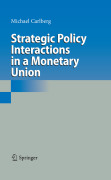
This book studies the strategic policy interactions in a monetary union. The leading protagonists are the European Central Bank and national governments. The target of the ECB is low inflation in Europe. The targets of a national government are low unemployment and a low structural deficit. There are demand shocks, supply shocks, and mixed shocks. There are country-specific shocks and common shocks. This book develops a series of basic, intermediate, and more advanced models. Here the focus is on the Nash equilibrium. The key questions are: Given a shock, can policy interactions reduce the existing loss? And to whatextent can they do so? Another topical issue is policy cooperation. To illustrate all of this there are a lot of numerical examples. Provides readers with a practical grasp of the macroeconomic principles necessary to understand a monetary union With numberical simulations of monetary policy, fiscal policy, and wage policy Describes how policy interactions can reduce the existing loss in case of a given shock Focus on Nash equilibrium INDICE: The Monetary Union as a Whole: Absence of a Deficit Target.- The Monetary Union as a Whole: Presence of a Deficit Target.- The Monetary Union ofTwo Countries: Absence of a Deficit Target.- The Monetary Union of Two Countries: Presence of a Deficit Target.
- ISBN: 978-3-540-92750-1
- Editorial: Springer
- Encuadernacion: Cartoné
- Páginas: 270
- Fecha Publicación: 01/01/2009
- Nº Volúmenes: 1
- Idioma: Inglés
